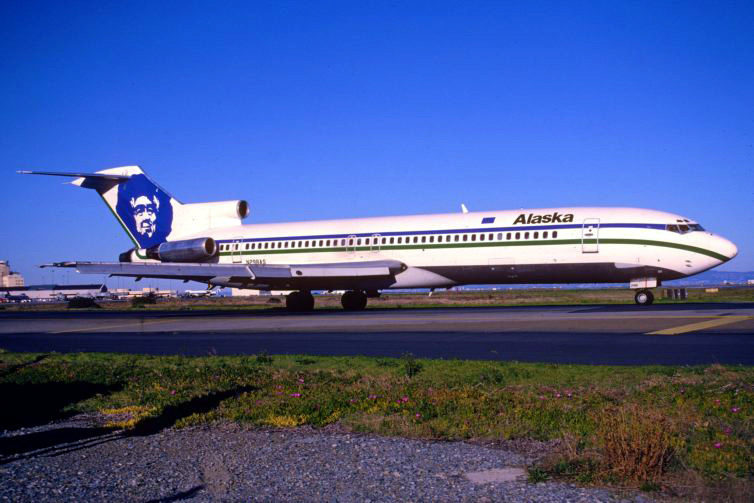
A classic Alaska Airlines Boeing 727-200 taken in 1989 – Photo: Aero Icarus | FlickrCC
The United States’ fifth-largest air carrier ’“ Alaska Airlines ’“ traces its roots deep into American history; in fact, the airline began in its namesake’s state nearly 27 years before Alaska achieved statehood. The formerly localized west coast regional air carrier boasts an impressive route structure, serving 116 destinations with over 1,200 daily departures. After the 2016 acquisition of San Francisco-based Virgin America, Alaska Airlines began a new phase of operations, utilizing its inheritance of 67 Airbus aircraft and dozens of new routes. When mainline service is combined with wholly-owned subsidiary Horizon Air and contracted carrier SkyWest Airlines, Alaska Airlines proudly boats the honor of operating the ’œMost West Coast’ flights each day.
However, Alaska Airlines and its affiliates have carefully expanded their daily operations far beyond the western United States, serving eastern seaboard destinations from Boston to Ft. Lauderdale. In 2014, 25% of all Alaska Airlines daily departures traveled across North America; after the Virgin America acquisition a mere four years later, that figure has nearly doubled. Simultaneously, growth to areas outside of the continental U.S. remains relatively stable and, in some cases, diminished. After connecting Bellingham, Washington to various Hawaiian destinations for nearly a decade, Alaska Airlines announced cessation of all Bellingham nonstop flights except service to Seattle-Tacoma. Growth within the airline’s namesake state of Alaska remains stagnant; service to Mexico faces a similar outcome.
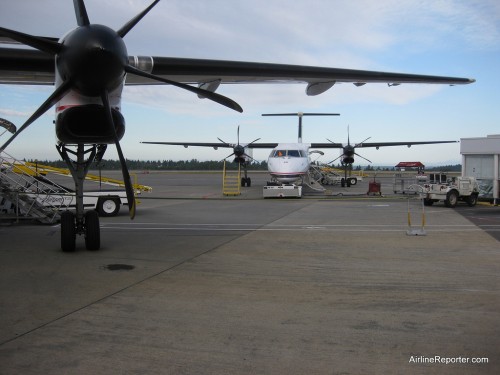
Horizon Q400s at Seattle
Alaska Airlines, alongside subsidiary Horizon Air and its partner SkyWest Airlines ’“ through a capacity purchase agreement ’“ has strategically eliminated under performing routes over the recent years. Instead, Alaska has elected to beef up its west coast hubs to maintain a stronghold among residents along the west coast. After the 2008 merger of Delta and Northwest, ferocious competition rose in former Alaska Airlines strongholds, specifically Seattle and Portland. Delta Air Lines maintains an expansive international network from Seattle, leading to recent growth and additions in domestic service and direct competition with Alaska Airlines. To combat, recent Alaska Airlines strategic decisions can be categorized into three distinct categories: Streamlined regional operations, acquisition of Virgin America, and an ever-expanding route network.
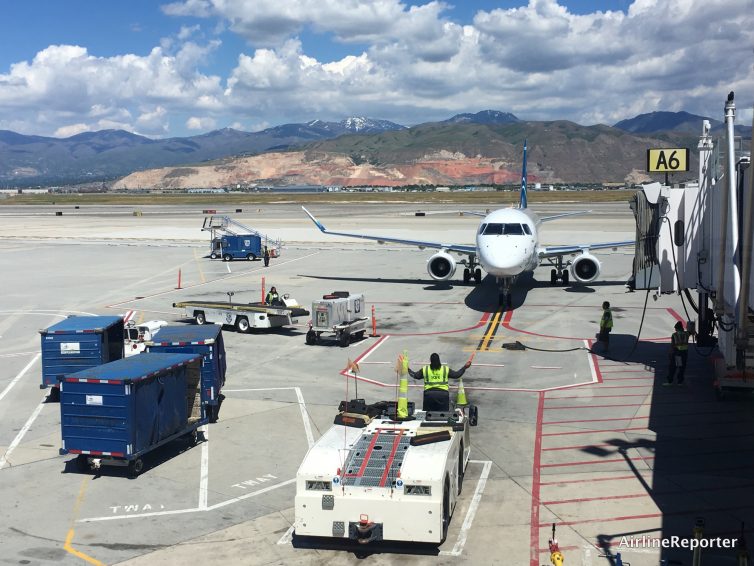
My first Alaska Air E175 pulls up to SLC
It has been a few years since I first flew on an Embraer E-Jet. That was on Air Canada, from Seattle to Toronto and I was sitting up front. The very long (for a smaller aircraft) flight was a breeze, but being in first class surely helped.
Since then, I have not had the opportunity to fly on another one. When I saw that Alaska Airlines was adding them to their fleet (via SkyWest and Horizon), I was excited. I figured it would only be a matter of time before I would get the chance to fly one, and when I recently took a trip down to Salt Lake City (SLC), I got my opportunity.
On my flight down, I flew on an Alaska 737-800 — been there, done that. But when I looked at my flight options back home, I saw that there was the option to fly on the E175. Yes’¦ that please.
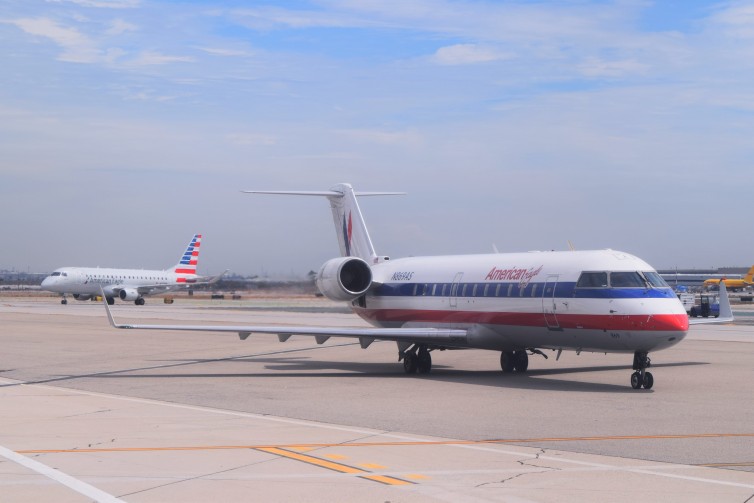
An American Eagle CRJ200 taxiing at LAX, with an Embraer 175 following – Photo: John Nguyen | AirlineReporter
Let’s face it… the 50-seat Bombardier CRJ200 isn’t very popular. At all. You’ll find countless articles and blogs about how much flyers dread flying in it, and how all-around terrible the experience was. Complaints were numerous: claustrophobic cabin, tiny overhead bins that fit only the smallest of carry-on bags, no first class, inoperable lavatories, and so on. This wasn’t limited to just one airline either; CR2s are found in the regional fleets for most of the major U.S. airlines. Coincidentally, many of them are operated under contract by the same regional carrier, SkyWest Airlines.
Does the CR2 deserve its bum rap? Maybe, maybe not (but probably). For some passengers, however, there is hope just over the horizon…
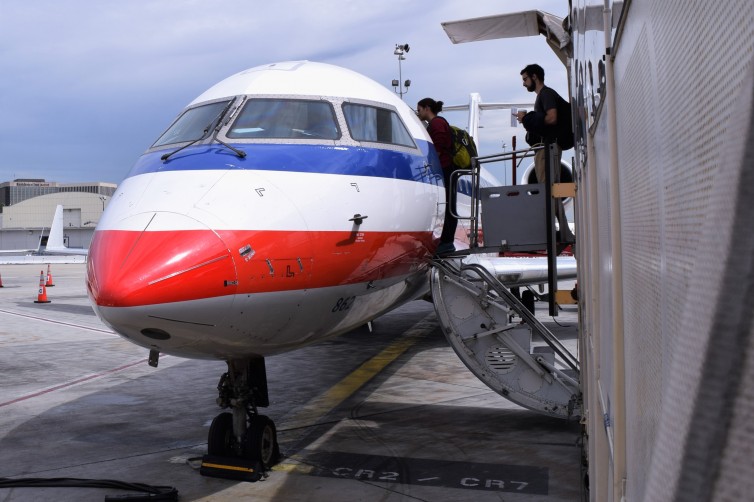
An American Eagle CRJ-200 during boarding at LAX – Photo: John Nguyen | AirlineReporter
Occasionally, I’ll be as lucky as some of my AirlineReporter colleagues to be flying high in a premium cabin while being waited on hand and foot (see, e.g., David Delagarza’s vacation flight in first-class on ANA, or Jacob’s Pfledger’s mile-high shower on Emirates). But as most of us can attest to, sometimes (or most of the time) we have to schlep it to get to where we want to go.
My wife and I traveled to Europe for a two-week whirlwind honeymoon tour that included 10 cities in eight countries, as well as eight individual flights within Europe. We found a smashing deal from Delta to experience premium economy on Air France’s Airbus A380 to Paris. There was just one slight issue: our Air France flight took off from San Francisco, but we live in Southern California — over 350 miles away. The solution: flying in the much-maligned CRJ-200. What sort of life decisions did I get wrong to lead me to suffering this mighty indignity?
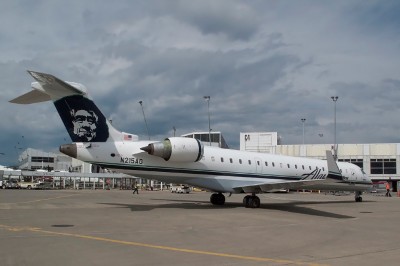
Alaska Airlines Bombardier CRJ-700 (N215AG) operated by Skywest seen at SEA.Photo by Keith Draycott.
Not too long ago, Seattle-based Horizon Air flew CRJ-700s for the Alaska Air Group. Then, Horizon announced they would get rid of the CRJ-700s and only fly a fleet of Bombardier Q400s). Shortly thereafter, Alaska announced they would absorbthe Horizon brand. Now, Alaska Airlines has contracted out with Skywest to fly Bombardier CRJ-700 regional jets on some of their west coast routes.
The Alaska Air Group felt there was still a need for a 70-person regional jet to serve some of their west coast destinations, resulting in Alaska Airlines contracting with Skywest to fly 22 daily CRJ-700 flights between Seattle/Portland and Burbank, Fresno, Long Beach, Ontario and Santa Barbara.
Interesting enough, Skywest is leasing the CRJ-700s from Horizon Air and flying them for Alaska under the new brand. The regional jets will sport the Alaska Airlines livery with a smaller “Skywest” on the fuselage. The interior will have blue leather seating, to match what you might find on an Alaska Air Boeing 737. However, the service will mirror what you would expect from flying on Horizon Air (yay free beer and wine).
“Alaska’s goal is to create a consistent customer experience on all of its regional-aircraft flights and provide a level of service including beer and wine that will compete against other regional airlines that offer a first class cabin,” Marianne Lindsey, Alaska Airlines Corporate Communications explained to Airline Reporter. “Coffee, napkins, cups, the inflight magazine, flight attendant uniforms and flight attendant announcements will match Alaska’s. Boarding passes and a decal next to the aircraft boarding door will indicate the flights are being operated for Alaska by SkyWest.”
Horizon hopes to have a single fleet of Q400’s by June 1st, matching Alaska’s single fleet of Boeing 737s. It becomes more economical for Horizon to lease the aircraft through Skywest since they have many more CRJs in their fleet, allowing economies of scale that Horizon or Alaska cannot match.
Horizon Air employees are trained to work with the CRJ-700, but since they will now be operated by Skywest, there will be some operational changes that have required employees to go through some re-training. “More than 2,200 employees at Alaska, Horizon, SkyWest and our partner vendors have been trained,” Lindsey explained. “More than 40 computer systems have been integrated and more than 400 processes have been confirmed–all to ensure safety and compliance, as well as a seamless product for our customers.”
Alaska didn’t indicate that it immediate plans for additional routes to be flown by the CRJ-700s. “We’re continually evaluating demand in all Alaska markets and will ensure the aircraft type and frequency (or capacity) continue to match demand throughout the Alaska system,’ Lindsey confirmed.
I would imagine there could be some hiccups with so many changes happening at one time for the new Alaska, old Horizon and the addition of Skywest. However, Alaska has a good track record of keeping people informed and trying to make the changes unnoticeable to their customer. Although many of us airline geeks will notice a change of aircraft type and livery, most people just want to get from point A to B as safe and cheaply as possible.
Being a Seattle native, I have mixed feelings seeing the Horizon brand slowly going away. Alaska needs to be able to compete and keep themselves a strong independent airline. They have weathered many economic downturns without having to sell or merge. It is a love/hate relationship and it helps that Alaska Air’s livery looks so darn good on the Bombardier Q400 and CRJ-700.
Things of interest:
* Schedule of the Skywest CRJ-700s
* Photo of CRJ-700 in Horizon livery (N601QX which is now N215AG)
* An ex-Horizon CRJ-700 caught in Atlanta (N604QX)
* Photo of Alaska livery on CRJ-700 in flight (N215AG)
* Another photos of CRJ in AS livery on the ground (N215AG)
Image by Keith Draycott via Flickr





